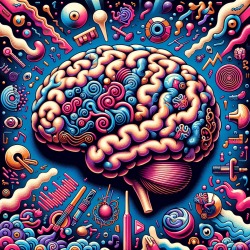Introduction
Welcome to a fascinating exploration of the cerebellum's role in perceptual disturbances! The cerebellum, often associated with motor control, has emerged as a key player in cognitive and perceptual functions. This blog dives into the insights from the research article "A Case Report of Perceptual Disturbances with Incidental Calcifications in the Cerebellum" and offers practical tips for practitioners looking to enhance their understanding and skills.
The Cerebellum: More Than Just Motor Control
Traditionally, the cerebellum has been viewed as a center for motor coordination. However, recent research highlights its involvement in cognitive and perceptual processes. The cerebellum's connections with nonmotor areas of the nervous system, including cognitive, affective, and perceptual regions, suggest a broader role in brain function.
Case Study Insights
The case study presented in the research article involves a 58-year-old woman experiencing auditory hallucinations and incidental cerebellar calcifications. Despite no prior history of psychiatric conditions, the patient reported hearing multiple voices, which were distressing and persistent. Neuroimaging revealed calcifications in the cerebellum, suggesting a potential link between cerebellar pathology and perceptual disturbances.
Implications for Practitioners
For practitioners, this case underscores the importance of considering cerebellar involvement in perceptual and cognitive disorders. Here are some practical steps to enhance your practice:
- Stay Informed: Keep up with the latest research on cerebellar functions and their implications for mental health.
- Integrate Multidisciplinary Approaches: Collaborate with neurologists and other specialists to gain a comprehensive understanding of cerebellar-related conditions.
- Consider Neuroimaging: Utilize advanced imaging techniques, such as fMRI and PET scans, to assess cerebellar involvement in patients with perceptual disturbances.
- Explore Non-Pharmacological Interventions: Cognitive Behavioral Therapy (CBT) and other therapeutic modalities may offer effective strategies for managing perceptual disturbances.
Encouraging Further Research
The case study highlights the need for further research into the cerebellum's role in perception. Understanding the cerebellum's interactions with auditory and visual networks could lead to improved diagnostic and treatment approaches for perceptual disturbances.
Conclusion
The cerebellum's role in perceptual disturbances is an exciting area of study with significant implications for mental health practitioners. By staying informed and adopting a multidisciplinary approach, practitioners can enhance their skills and contribute to the growing body of knowledge in this field.
To read the original research paper, please follow this link: A Case Report of Perceptual Disturbances with Incidental Calcifications in the Cerebellum.










